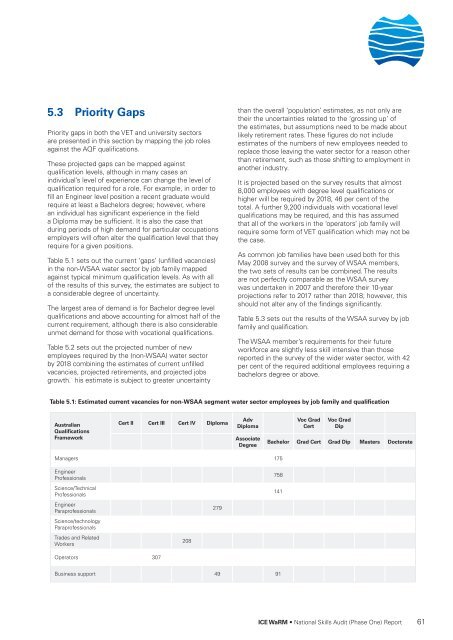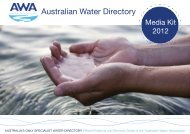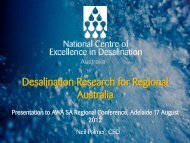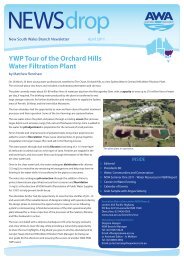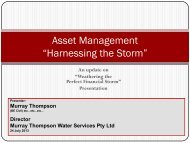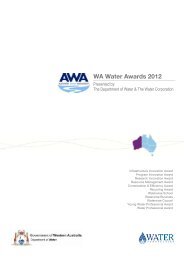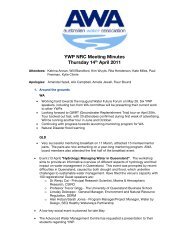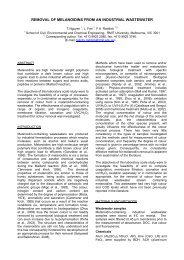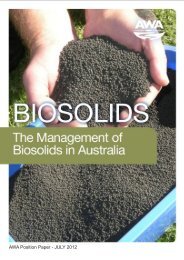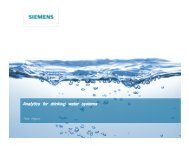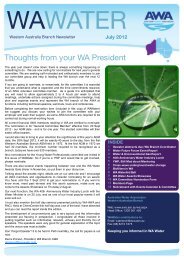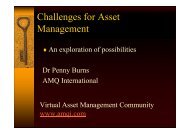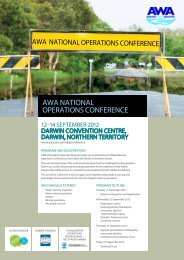National Water Skills Audit - Australian Water Association
National Water Skills Audit - Australian Water Association
National Water Skills Audit - Australian Water Association
- No tags were found...
You also want an ePaper? Increase the reach of your titles
YUMPU automatically turns print PDFs into web optimized ePapers that Google loves.
5.3 Priority GapsPriority gaps in both the VET and university sectorsare presented in this section by mapping the job rolesagainst the AQF qualifications.These projected gaps can be mapped againstqualification levels, although in many cases anindividual’s level of experience can change the level ofqualification required for a role. For example, in order tofill an Engineer level position a recent graduate wouldrequire at least a Bachelors degree; however, wherean individual has significant experience in the fielda Diploma may be sufficient. It is also the case thatduring periods of high demand for particular occupationsemployers will often alter the qualification level that theyrequire for a given positions.Table 5.1 sets out the current ‘gaps’ (unfilled vacancies)in the non-WSAA water sector by job family mappedagainst typical minimum qualification levels. As with allof the results of this survey, the estimates are subject toa considerable degree of uncertainty.The largest area of demand is for Bachelor degree levelqualifications and above accounting for almost half of thecurrent requirement, although there is also considerableunmet demand for those with vocational qualifications.Table 5.2 sets out the projected number of newemployees required by the (non-WSAA) water sectorby 2018 combining the estimates of current unfilledvacancies, projected retirements, and projected jobsgrowth. his estimate is subject to greater uncertaintythan the overall ‘population’ estimates, as not only aretheir the uncertainties related to the ‘grossing up’ ofthe estimates, but assumptions need to be made aboutlikely retirement rates. These figures do not includeestimates of the numbers of new employees needed toreplace those leaving the water sector for a reason otherthan retirement, such as those shifting to employment inanother industry.It is projected based on the survey results that almost8,000 employees with degree level qualifications orhigher will be required by 2018, 46 per cent of thetotal. A further 9,200 individuals with vocational levelqualifications may be required, and this has assumedthat all of the workers in the ‘operators’ job family willrequire some form of VET qualification which may not bethe case.As common job families have been used both for thisMay 2008 survey and the survey of WSAA members,the two sets of results can be combined. The resultsare not perfectly comparable as the WSAA surveywas undertaken in 2007 and therefore their 10-yearprojections refer to 2017 rather than 2018; however, thisshould not alter any of the findings significantly.Table 5.3 sets out the results of the WSAA survey by jobfamily and qualification.The WSAA member’s requirements for their futureworkforce are slightly less skill intensive than thosereported in the survey of the wider water sector, with 42per cent of the required additional employees requiring abachelors degree or above.Table 5.1: Estimated current vacancies for non-WSAA segment water sector employees by job family and qualification<strong>Australian</strong>QualificationsFrameworkCert II Cert III Cert IV DiplomaAdvDiplomaAssociateDegreeVoc GradCertVoc GradDipBachelor Grad Cert Grad Dip Masters DoctorateManagers 175EngineerProfessionalsScience/TechnicalProfessionals758141EngineerParaprofessionals279Science/technologyParaprofessionalsTrades and RelatedWorkers208Operators 307Business support 49 91ICE WaRM • <strong>National</strong> <strong>Skills</strong> <strong>Audit</strong> (Phase One) Report 61


